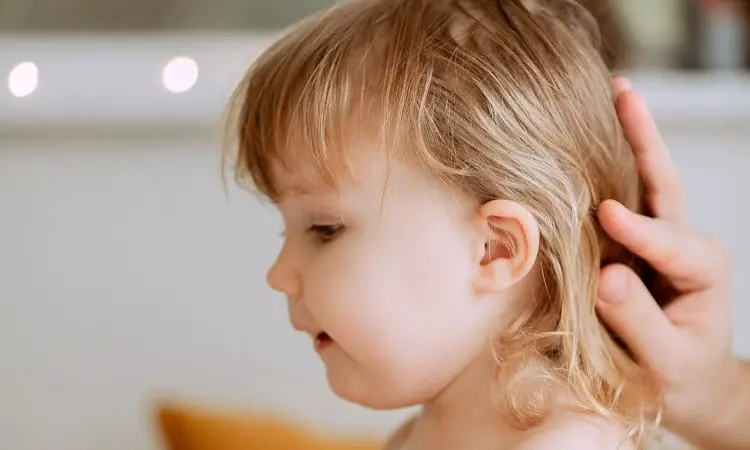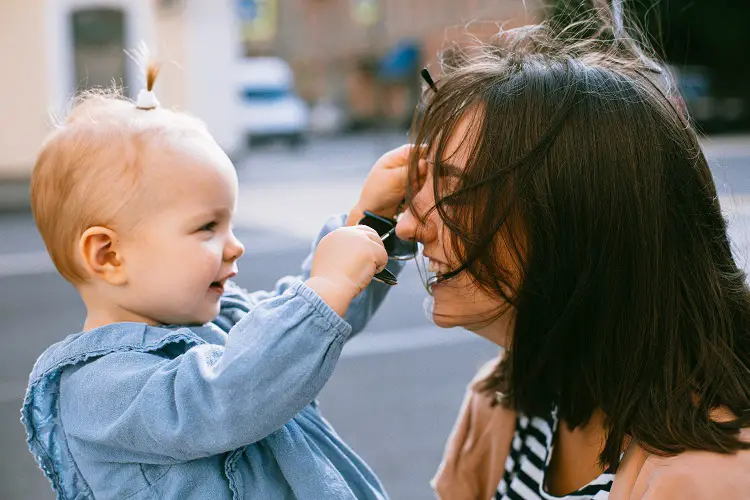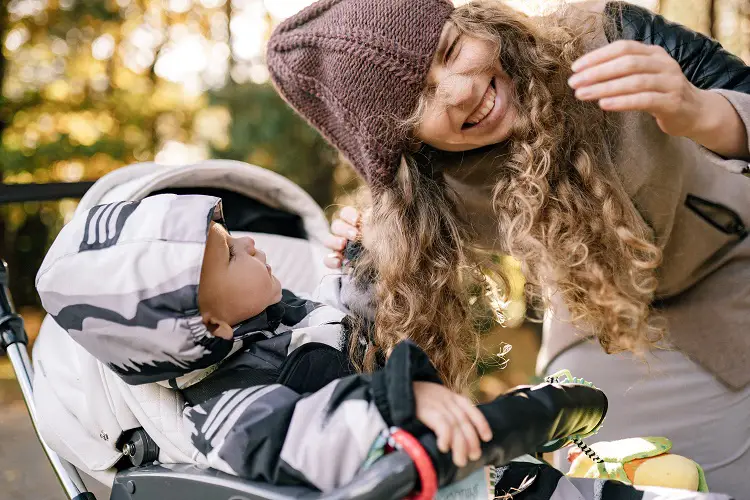Babies develop a lot of funny and weird behaviors as they grow older. Some of these behaviors make parents worry greatly about the health and normalcy of their baby. A visit to a pediatric clinic would amuse you and make you smile at the love parents have for their babies.
This is especially common in first-time parents. One behavior that babies should exhibit that could keep their parents worried is the pulling and eating of their hair.
In this article, we’ll explore how to stop babies from pulling and eating their hair. Read On…
Why Do Babies Pull and Eat Their Hair?

Before we discuss how to stop babies from pulling and eating their hair, we have to understand the reason why they do it first.
You know, it will be much easier to stop babies from pulling and eating their hair if we know why they do it. Below are some reasons why babies pull and eat their hair.
1. Stress and Anxiety
Yes, babies go through their bouts of stress and anxiety. It is a fallacy that babies have nothing that bothers them. Babies are beautiful little humans who are often preoccupied with the happenings of their world.
Just as you have your activities, babies have theirs too. They have their fingers to lick, their foods to eat, and their mothers to trouble with tantrums. See? Babies are not as free as you think they are.
When babies begin to feel overwhelmed by their environments or the people around them, they’d try to create a balance for themselves by doing something that distracts them from the primary source of their anxieties.
What could this distraction be? It is the pulling and eating of their hairs.
2. Exploration
Babies also pull and eat their hair in their quest for personal exploration. Babies are intrigued by almost everything around them and their hair is no exception.
They pull their hair to have a feel of what the woolly mass and soft texture feel like.
Then they satisfy their curiosity further by having a taste of it. Babies have very sharp senses. They sharpen these senses more by exploring everything that they can lay their hands on.
3. Self-Soothing
Babies also pull and eat their hair because they find it self-soothing and relaxing to do so. Hair pulling and eating aren’t the only self-soothing behaviors that are peculiar to babies.
Some of them suck their fingers and tongue while others rub their noses. Studies show that babies tend to fall asleep faster while engaging in these activities than when they are being rocked to sleep.
So, your baby may not necessarily be having any health problem because it pulls and eats its hair. It could be your baby just soothing itself the best way it knows.
4. Discomfort
Some babies pull and eat their hair to reduce the amount of pain and discomfort they feel at some points in their lives.
A perfect example of this is the teething period. Babies often feel discomfort on their gums during teething. Pulling of hair will help the baby bear the pain.
5. Seeking Attention
This is most peculiar to toddlers and babies above six months or more who can understand simple instructions and signal behavior from their parents.
Nothing fascinates a child more than engaging in that one behavior that you forbade it from.
You know, it is more like a childish rebellion whose main motive is to upset you or get your attention. Yes, your baby can choose to pull its hair to get your attention.
It could stem from a desire to play around with you. It could also stem from a feeling of neglect. Babies live on attention.
6. Baby Trich
This is a disorder whereby a baby can’t resist the desire to pull its hair and eat it. This disorder could happen to any baby.
When your baby’s hair pulling and eating becomes disturbingly excessive, it could be a symptom of this disorder.
This disorder usually happens between the ages of 9-13, but can occur in children as young as 18 months old. Seek the help of a pediatrician and correct the anomaly with Cognitive Behavioral Therapy (CBT).
How To Treat Baby Trich
Pediatricians primarily correct this disorder with cognitive-behavioral therapy (CBT). This kind of treatment helps your baby become aware of their activities.
The key objective of this treatment is to educate your baby on how to recognize the emotions and triggers of the hair-pulling.
However, based on the age of the baby, this activity could involve anything from putting on bracelets to carrying something around as a reminder.
The second phase of treatment starts as soon as your baby understands the problem. This method involves reversal therapy.
Your baby doctor might recommend you place bandages on your baby’s fingers to make it difficult for them to pull their hair. Alternatively, you can tie their hair back in a ponytail, or cover their hair with a hat.
For older babies who often like playing with their hair, medical practitioners recommend offering them an item with a similar texture to play with, for example, it could be a textured pencil topper, feather, or ribbon.
7. Pica (Eating Hair)
Just as pregnant women crave strange things to eat, such as dirt or chalk, the same thing applies to young children.
As mentioned earlier, babies can try eating their hair maybe once or twice out of curiosity and then stop. But this is not so for Pica whereby the baby persistently eats more than one non-food item for at least a month.
This condition is not something to joke about. Those substances (could be spoiled food items, fabric, dirty toys, etc) your baby puts in their mouth can pose a health hazard to the baby which could lead to serious infection or intestinal problems, and even death.
Why Does Pica Occur?
Just like baby trich, medical practitioners are still unsure of the exact causes of pica. However, certain circumstances might contribute to its development and they include:
- Nutritional deficiencies: Sometimes a lack of important nutrients like iron or zinc can contribute to a craving for a non-food item.
- Malnutrition: Although, this is not a common issue in the U.S. This generally applies in underdeveloped countries, especially in Africa where children often resort to eating soil or clay.
- Parental neglect or Lack of supervision: This could also contribute to a craving for a non-food item in babies.
- Other medical conditions: Like Autism or other developmental health issues, for instance.
- Mental health problems: Like schizophrenia and OCD (obsessive-compulsive disorder).
How Can This Be Treated?
This condition can be treated by placing mittens on their hands or giving the baby stuffed toys or blankets to use as comfort while distracting them as well.
Secondly, as a parent, you must ensure that your baby is getting all the nutrition he or she needs. Your healthcare provider might carry out a series of tests to check the mineral levels are normal.
If there happens to be a drop, the doctor will suggest including more nutritious food in your baby’s diet.
If they happen to be any other underlying condition, you should continue checkups. The good news is most young kids tend to outgrow this condition as they grow.
Read Also: How To Wash Newborn Hair For The First Time
How To Stop Babies From Pulling And Eating Their Hair

1. Distract Them from the Act
This is one of the most effective and proven methods to stop your baby from pulling and eating its hair. Keep your baby occupied with interesting activities.
Doing this will take away a great amount of the baby’s attention from the hair. Doing this over time can help you eradicate the behavior.
2. Cuddle
Cuddling your babies and playing with them when they pull and eat their hair can also help them stop. Like we discovered earlier, hair pulling and eating are self-soothing mechanisms for some babies.
Cuddling them and cosseting them with affection can soothe them much better thereby taking their desire to pull and eat their hair away.
3. Deny Them the Attention
For babies who pull and eat their hair because of attention, denying them that attention would help them stop.
If you keep on reacting to them when they pull their hair or eat it, they would keep on doing it to get more reactions from you.
If you don’t react, with time, they’d get bored of seeking attention with that method. Resist the desire to resist when they start, you’d be amazed at how much it could change.
4. Massage
Some babies pull their hair when they feel discomfort. Especially the discomfort that is common with teething.
If this is the case with your baby, a warm hug and gentle massages on the scalp can be of great help. Massage the baby’s scalp gently and hug the baby while at it. This can be quite effective too.
5. Chop Your Baby’s Hair
If you are worried about your baby’s hair pulling and eating habits, you can cut his hair. If your baby’s hair is long, then it is inevitable for them not to pull their hair.
However, if you don’t feel comfortable cutting his hair, then you may tie his hair in a ponytail.
6. Be Consistent with Your Words
Your baby will need you to tell him everything over and over again each time. Babies won’t understand the implications of pulling their hair or your long tresses immediately.
This is where patience and consistency come into play because there’s still time for your baby to understand words, their meaning, and how his actions affect him and the people around him.
By repeatedly distracting your baby’s mind and replacing hair pulling with something better, you could help him stop pulling his hair.
Related Posts:
- When Do Babies Get Eyebrows
- When Do Babies Hair Change Color
- How To Stop Baby From Sucking Thumb
- Parenting Tips (Dos and Don’ts of Raising a Child)
- Newborn Safety Checklist For First Time Parents
Conclusion
We believe this article has been able to enlighten you on how to stop babies from pulling and eating their hair and also why they do it. You don’t have to get worked up about some of these ‘strange’ behaviors anymore.
If at any time you found your baby pulling his hair, stay calm as you correct the behavior. Remember, in young babies light hair pulling is quite normal is not something to be worried about.
However, if your baby begins to develop bald spots, or you see him doing it frequently, keep trying to distract or redirect their attention to something else whenever you notice them going for their hair. Alternatively, a simple visit to the pediatrician would fix it and equip you with the necessary information.
